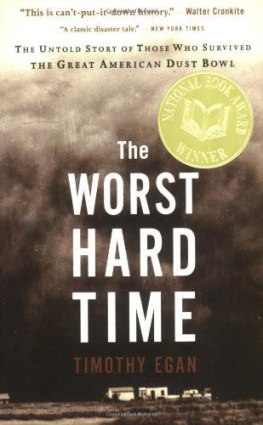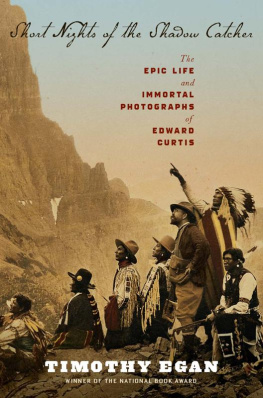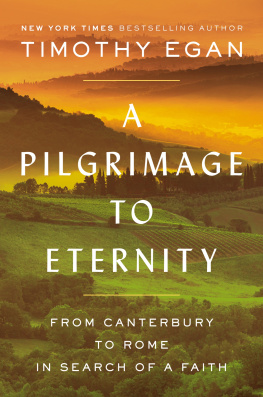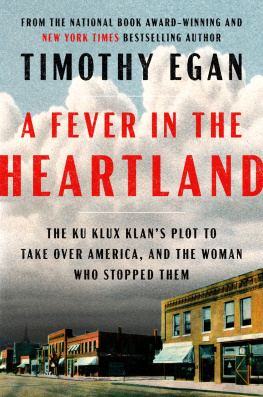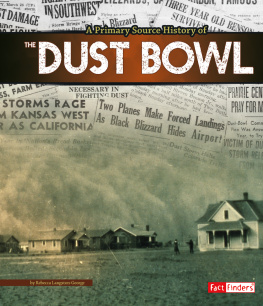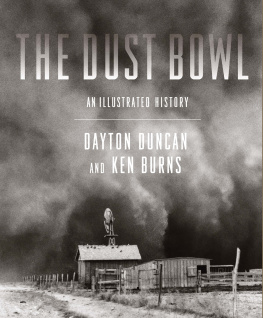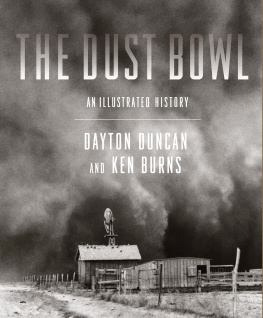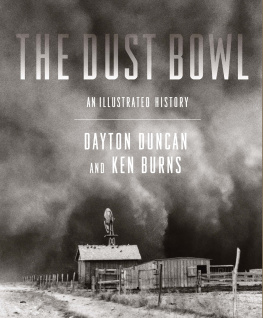Timothy Egan - The Worst Hard Time: The Untold Story of Those Who Survived the Great American Dust Bowl
Here you can read online Timothy Egan - The Worst Hard Time: The Untold Story of Those Who Survived the Great American Dust Bowl full text of the book (entire story) in english for free. Download pdf and epub, get meaning, cover and reviews about this ebook. year: 2006, publisher: Mariner Books, genre: Home and family. Description of the work, (preface) as well as reviews are available. Best literature library LitArk.com created for fans of good reading and offers a wide selection of genres:
Romance novel
Science fiction
Adventure
Detective
Science
History
Home and family
Prose
Art
Politics
Computer
Non-fiction
Religion
Business
Children
Humor
Choose a favorite category and find really read worthwhile books. Enjoy immersion in the world of imagination, feel the emotions of the characters or learn something new for yourself, make an fascinating discovery.
- Book:The Worst Hard Time: The Untold Story of Those Who Survived the Great American Dust Bowl
- Author:
- Publisher:Mariner Books
- Genre:
- Year:2006
- Rating:4 / 5
- Favourites:Add to favourites
- Your mark:
- 80
- 1
- 2
- 3
- 4
- 5
The Worst Hard Time: The Untold Story of Those Who Survived the Great American Dust Bowl: summary, description and annotation
We offer to read an annotation, description, summary or preface (depends on what the author of the book "The Worst Hard Time: The Untold Story of Those Who Survived the Great American Dust Bowl" wrote himself). If you haven't found the necessary information about the book — write in the comments, we will try to find it.
The Worst Hard Time: The Untold Story of Those Who Survived the Great American Dust Bowl — read online for free the complete book (whole text) full work
Below is the text of the book, divided by pages. System saving the place of the last page read, allows you to conveniently read the book "The Worst Hard Time: The Untold Story of Those Who Survived the Great American Dust Bowl" online for free, without having to search again every time where you left off. Put a bookmark, and you can go to the page where you finished reading at any time.
Font size:
Interval:
Bookmark:
T HE HIGH PLAINS never fully recovered from the Dust Bowl. The land came through the 1930s deeply scarred and forever changed, but in places it healed. All told, the government bought 11.3 million acres of dusted-over farm fields and tried to return much of it to grassland. The original intent was to purchase up to 75 million acres. After more than sixty-five years, some of the land is still sterile and drifting. But in the heart of the old Dust Bowl now are three national grasslands run by the Forest Service. The land is green in the spring and burns in the summer, as it did in the past, and antelope come through and graze, wandering among replanted buffalo grass and the old footings of farmsteads long abandoned. Some things are missing or fast disappearing: the prairie chicken, a bird that kept many a sodbuster alive in the dark days, is in decline, its population down by 78 percent since 1966. The biggest of the restored areas is Comanche National Grassland, named for the Lords of the Plains, which covers more than 600,000 acres, much of it in Baca County. Plans are underway to reintroduce bison to the shortgrass prairie, as was done in tallgrass preserves in other parts of the Great Plains.
The Indians never returned, despite New Deal attempts to buy rangeland for natives. The Comanche live on a small reservation near Lawton, Oklahoma. They still consider the old bison hunting grounds between the Arkansas River and Rio Grande"where the wind blew free, and there was nothing to break the light of the sun," as Ten Bears saidto be theirs by treaty.
The trees from Franklin Roosevelt's big arbor dream have mostly disappeared. Nearly 220 million were planted, just as the president envisioned. But when regular rain returned in the 1940s and wheat prices shot up, farmers ripped out the shelterbelt trees to plant grain. Other trees died in cycles of drought over the last half a century. Occasionally, a visitor comes upon a row of elms or cottonwoods, sturdy and twisted from the wind. It can be a puzzling sight, a mystery, like finding a sailor's note in a bottle on an empty beach.
The United States was founded as a nation of farmers but less than 1 percent of all jobs are in agriculture now. On the plains, the farm population has shrunk by more than 80 percent. The government props up the heartland, ensuring that the most politically connected farms will remain profitable. But huge sections of mid-America no longer function as working, living communities. The subsidy system that was started in the New Deal to help people such as the Lucas family stay on the land has become something entirely different: a payoff to corporate farms growing crops that are already in oversupply, pushing small operators out of business. Some farms get as much as $360,000 a year in subsidies. The money has almost nothing to do with keeping people on the land or feeding the average American.
Only a handful of family farmers still work the homesteads of No Man's Land and the Texas Panhandle. To keep agribusiness going, a vast infrastructure of pumps and pipes reaches deep into the Ogallala Aquifer, the nation's biggest source of underground freshwater, drawing the water down eight times faster than nature can refill it. The aquifer is a sponge, stretching from South Dakota to Texas, which filled up when glaciers melted about 15,000 years ago. It provides about 30 percent of the irrigation water in the United States. With this water, farmers in Texas were able to dramatically increase production of cotton, which no longer has an American market. So cotton growers, siphoning from the Ogallala, get three billion dollars a year in taxpayer money for fiber that is shipped to China, where it is used to make cheap clothing sold back to American chain retail stores like Wal-Mart. The aquifer is declining at a rate of 1.1 million acre-feet a daythat is, a million acres, filled to a depth of one foot with water. At present rates of use, it will dry up, perhaps within a hundred years. In parts of the Texas Panhandle, hydrologists say, the water will be gone by 2010.
During a three-year drought in the 1950s, dusters returned. There were big storms covering roads and spinning over towns but nothing like Black Sunday. Droughts in 19741976 and 20002003 made the soil drift. But overall, the earth held much better. Why no second Dust Bowl? In 2004, an extensive study of how farmers treated the land before and after the great dusters of the 1930s concluded that soil conservation districts kept the earth from blowing. There was also irrigation water from the Ogallala to compensate for drought, but it was not available in many parts of the dry farming belt. What saved the land, this study found, was what Hugh Bennett had started: getting farmers to enter contracts with a soil conservation district and manage the land as a single ecological unit. By 1939, about 20 million acres in the heart of the Dust Bowl belonged to one of these units. Hugh Bennett died in 1960 at the age of seventy-nine. He is buried in Arlington National Cemetery. His legacy, the soil conservation districts spread throughout America, is the only New Deal grassroots operation that survives to this day.
Dalhart still stands, a windblown and dog-eared town at the crossroads of three highways. It never recovered its population from pre-1930; barely six thousand people live in Dallam County now. At the entrance to town is a striking monument: an empty horse saddle, dedicated to the XIT cowboys. Every year, Dalhart holds a celebration for the old XIT ranch and the ghosts of cowboys who ran through its grass during the glory years. After moving out of Dalhart, John McCarty, the town's biggest booster, never returned. In his later years, he took up painting, concentrating on art that depicted dust storms as heroic and muscular. Born in 1900, the same year as Dalhart, McCarty died in 1974. In a home he built at the edge of town, Melt White lives with his wife of more than sixty years, Juanita. He worked as a house painter and paperhanger, though he still considers himself a cowboy by trade and inclination. He keeps a couple of horses out back on land next to the old XIT. He curses the day farmers came to the Panhandle and tore up the grass.
Boise City is alivebut barely. With just three thousand people, Cimarron County has lost nearly half its pre-Dust Bowl population. Fred Folkers was ten thousand dollars in debt at the start of the war. But four-dollar wheat got him out of it, in the same way that wartime factory production finally got the United States out of the Depression. In 1948, at age sixty-six, Fred had a heart attack. He continued to farm right up until his death in 1965. His wife, Katherine, outlived him by ten years. She died at the age of ninety. The children, Faye and Gordon, still own the homestead, land where Katherine ironed centipedes in the walls of the dugout. Hazel Lucas Shaw had another child, Jean Beth, to go with her son, Charles, Jr. Hazel's husband, Charles, died in 1971, of heart disease. After surviving the Dust Bowl and two subsequent tornadoes, Hazel outlived all her friends from Boise City. She died in 2003 at the age of ninety-nine. Though she never returned to live there, she told her grandchildren she always missed No Man's Land.
Inavale, Nebraska, where the Hartwells lived, is a ghost town. Webster County, with four thousand people, has lost more than 60 percent of its population from the 1930s. Years ago, a neighbor found Verna Hartwell burning her late husband's diary. The diary was rescued and after Verna's death turned over to the Nebraska Historical Society in Lincoln.
Approaching his ninetieth birthday, Ike Osteen lives with his wife, Lida Mae, not far from the dugout where the family of nine children passed their days in a hole in the ground. After leaving Baca County, Ike worked on the railroad and road projects, and then joined the Army. By the time Hitler's forces occupied most of Europe, Osteen was in boot camp. The soldier from the dugout landed in France on D-Day, June 6, 1944, fought the Germans through hedgerows, saw friends bleed and die. When the war was over, he thought about his place in the world and was drawn back to Baca County. It takes a certain kind of person to make peace with land that has betrayed them, but that is the way with home. Ike's mother died at the age of ninety-two. Most days, Ike puts in a full day's work around the house and usually spends some part of an afternoon sorting through the living museum of his life on the High Plains. He loves it still.
Font size:
Interval:
Bookmark:
Similar books «The Worst Hard Time: The Untold Story of Those Who Survived the Great American Dust Bowl»
Look at similar books to The Worst Hard Time: The Untold Story of Those Who Survived the Great American Dust Bowl. We have selected literature similar in name and meaning in the hope of providing readers with more options to find new, interesting, not yet read works.
Discussion, reviews of the book The Worst Hard Time: The Untold Story of Those Who Survived the Great American Dust Bowl and just readers' own opinions. Leave your comments, write what you think about the work, its meaning or the main characters. Specify what exactly you liked and what you didn't like, and why you think so.

